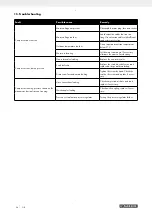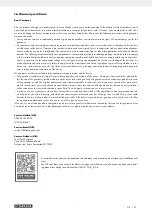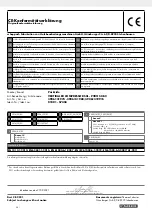
17
GB
The device may only be operated by persons who are aged
16 and above. An exception to this is use by minors if the use
takes place as part of occupational training in order to gain
proficiency under the supervision of an instructor.
Please note that our equipment was not designed with the inten-
tion of use for commercial or industrial purposes. We assume
no guarantee if the device is used in commercial or industrial
applications, or for equivalent work.
6. General power tool safety warnings
m
WARNING - Read all safety instructions, instruc-
tions, illustrations and technical data for this elec-
tric tool.
Failure to follow all instructions listed below may result in elec-
tric shock, fire and/or serious injury.
Save all warnings and instructions for future refer-
ence.
The term “power tool” in the warnings refers to your mains-
operated (corded) power tool or battery-operated (cordless)
power tool.
Work area safety
a. Keep your work area clean and well-lit.
Cluttered
or dark areas invite accidents.
b. Do not operate electric tools in explosive at-
mospheres, such as in the presence of flam-
mable liquids, gases or dust.
Electric tools produce
sparks that may ignite dust or vapours.
c. Keep children and other people away while us-
ing the electric tool.
You may lose control of the power
tool if distracted.
Electrical safety
a. Power tool plugs must match the outlet. Never
modify the plug in any way. Do not use any
adapter plugs with earthed (grounded) power
tools.
Unmodified plugs and matching outlets will reduce
risk of electric shock.
b. Avoid body contact with earthed surfaces, such
as pipes, heaters, ovens and refrigerators.
There
is an increased risk of electric shock if your body is earthed
or grounded.
c. Do not expose power tools to rain or wet condi-
tions.
Water entering a power tool will increase the risk
of electric shock.
d. Do not abuse the cord. Never use the cord for
carrying, pulling or unplugging the power tool.
Keep cord away from heat, oil, sharp edges or
moving parts.
Damaged or entangled cords increase
the risk of electric shock.
e. If you work with an electric tool outdoors, only
use extension cables that are also suitable for
outdoor use.
Using an extension cable suitable for out-
door use reduces the risk of an electric shock. Only use
approved and appropriately identified extension cables
for use outdoors. Only use cable reels in the unrolled state.
f. If operating a power tool in a damp location
is unavoidable, use a residual current circuit
breaker with a trigger current of 30 mA or less
to protect the power supply.
Using a fault-current
circuit breaker reduces the risk of an electric shock.
Personal safety
a. Stay alert, watch what you are doing and use
common sense when operating a power tool.
Do not use a power tool while you are tired or
under the influence of drugs, alcohol or medica-
tion.
A moment of carelessness when using electrical tools
can result in serious injuries.
b. Use personal protective equipment. Always
wear eye protection.
Wearing personal protective
equipment, such as dust masks, anti-slip safety shoes, safe-
ty helmet or hearing protection, depending on the type
and use of the electric tool, reduces the risk of injuries.
c. Prevent unintentional starting. Ensure the switch
is in the off-position before connecting to power
source and/or battery pack, picking up or carry-
ing the tool.
Carrying electric tools with your finger on the
switch or connecting electric tools to the power supply when
they are already switched on invites accidents.
d. Remove any adjusting key or wrench before turn-
ing the power tool on.
A wrench or a key left attached to
a rotating part of the power tool may result in personal injury.
e. Do not overreach. Keep proper footing and
balance at all times.
This enables better control of the
power tool in unexpected situations.
f. Dress properly. Do not wear loose clothing or
jewellery. Keep hair, clothing and gloves away
from moving parts.
Loose clothes, jewellery or long
hair can be caught in moving parts. When working out-
doors, rubber gloves and anti-slip footwear is recommend-
ed. Tie long hair back in a hair net.
g. If dust extraction and collection devices can be
mounted, make sure that they are connected
and used properly.
Use of dust collection can reduce
dust-related hazards.
h. Do not let familiarity gained from frequent use
of tools allow you to become complacent and
ignore tool safety principles.
A careless action can
cause severe injury within a fraction of a second.
Power tool use and care
a. Do not force the power tool. Use the correct
power tool for your application.
The correct power
tool will do the job better and safer at the rate for which it
was designed.
b. Do not use the power tool if the switch does not
turn it on and off.
Any power tool that cannot be con-
trolled with the switch is dangerous and must be repaired.
c. Disconnect the plug from the power source
and/or remove the battery pack, if detachable,
from the power tool before making any adjust-
ments, changing accessories, or storing power
tools.
These precautionary measures will prevent the elec-
tric tool from starting unintentionally.
Summary of Contents for PVKO 50 B2
Page 3: ...1 5 6 4 3 7 2 1 3 2 8 10 9 11 2 1 7 5...
Page 4: ...5 4 A C 6 D A C 6 D 12 4 B D 6 7 7 7 1 7 3 7 2...
Page 32: ...27...
Page 34: ......
Page 35: ......















































